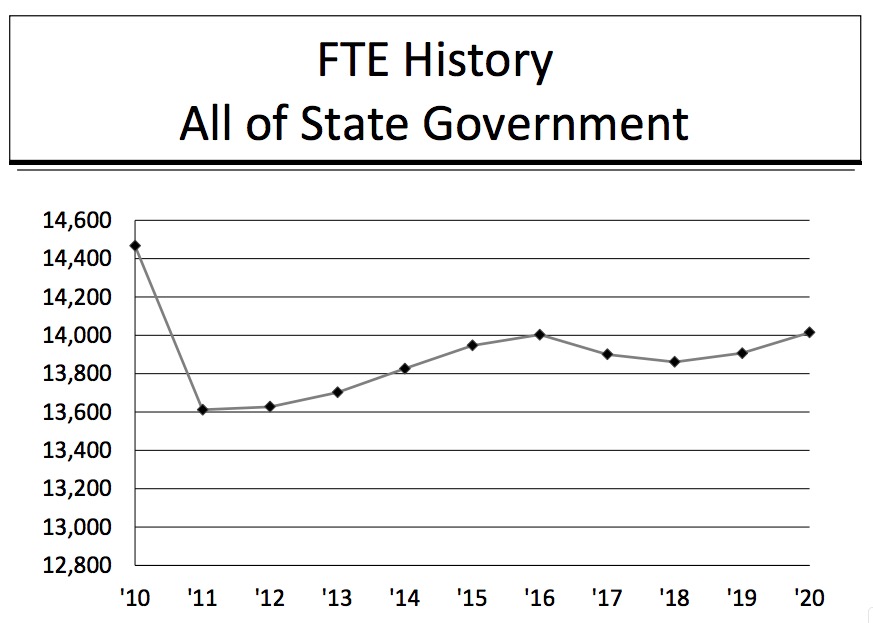But hey, we have plenty of room to hire Kristi Noem’s family and flunkies to cover for Jason Ravnsborg and more tax agents to tackle out-of-state vendors. As Governor Dennis Daugaard noted in his final budget address Tuesday, state government employment has decreased 3.1%, 451 fewer people, since Fiscal Year 2010.
Of course, all of that drop happened in one year, Fiscal Year 2011:

Fiscal Year 2011 was the real purge year, knocking 944.5 South Dakotans off the state payroll. Rounds had originally recommended cutting not quite 100 FTEs, but recession reality caught up with the Legislature.
Since then, Governor Daugaard has put back about a third of that cut, and for FY2020, he recommends getting us back over 14,000.
Note that, for all of his cheapness, Governor Daugaard still hasn’t done as good a job of depressing state employment directly under his control as agencies outside his control have:
- For offices outside the control of the Governor, total appropriated FTE changed from 6,485.2 in FY2010 to a recommended level of 6,168.6 for FY2020. This is a net decrease of 316.6, or 4.9%, over the decade.
- The recommended changes for these offices in the FY2020 budget are an increase of 29.3 FTE.
- For agencies under direct control of the Governor, total appropriated FTE changed from 7,980.4 in FY2010 to a recommended level of 7,846.1 for FY2020. This is a net decrease of 134.3, or 1.7%, over the decade.
- The recommended changes for these agencies in the FY2020 budget are an increase of 63.5 FTE [Bureau of Finance and Management, “Summary of Recommended Budget Adjustments,” Recommended FY2020 Budget, 2018.12.04, p. 16].
So counting from FY2011 to his final proposal for FY2020, Governor Daugaard would grow the state payrolls by 3%.
Watch for that latter FTE number to climb even higher once Kristi Noem and Matt McCaulley submit their crony budget.
With nursing homes closing throughout the state because of South Dakota’s miserly Medicaid reimbursement rates you would hope increasing Medicaid reimbursement rates would be a priority. Budgeting ZERO because of the Wayfare case is needlessly conservative and is simply a way to run up the state budget surpluses while ignoring the real needs of SD citizens.
The Partridge Amendment will in effect be a tax cut for tourists and visitors to South Dakota. The Wayfare money will, by definition, all be paid by South Dakota residents, the equal amount of money taxes will be cut will be split among all those who make SD purchases, residents and non-residents alike.
Great statistics, numbers, and graph. Yet, the rhino trick is cutting employees while vastly increasing state funds to contractors to do the work of the former employees (while delivering far lower services). Thus, including whether, and how much, service contracts increased, and how many employees those support, assists with completing the ‘state jobs’ picture.
John, youre right about that. Then they can squeeze the contractors, forgoing paying any benefits and making their lives tougher. The contractors are usually SD citizens.
Heck of a way to run a state.
Interesting—I’m looking at Debbo’s and John’s contracts and wondering which way privatization is worse: do we end up with more workers receiving fewer benefits and lower pay, or do we end up with more inefficiency as contractors pad their bids with more unaccountable profit in no-bid contracts?
Or do both effects happen, meaning that privatization leads to more concentration of wealth among South Dakota’s wealthy elites?
Nick makes a good point that the Partridge Amendment means shifting more of the burden to South Dakota residents.
John wrote:
to contractors to do the work of the former employees (while delivering far lower services)
Please link to the lower servies comment or is that just your opinion?
The State saves money in pension costs hiring contract workers which in turn saves taxpayer money.
I believe John is talking of wingnuts desires to privatize gubmint services so their campaign contributors get on the gravy train and sat at the same trough.